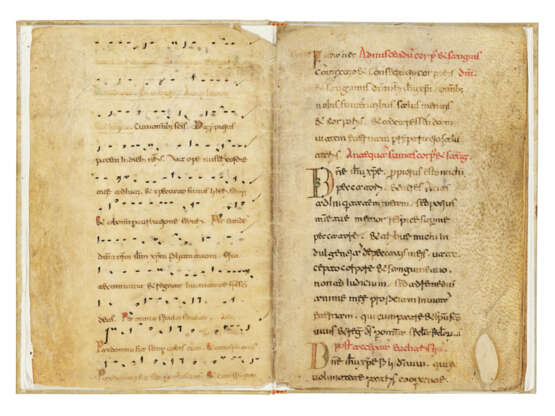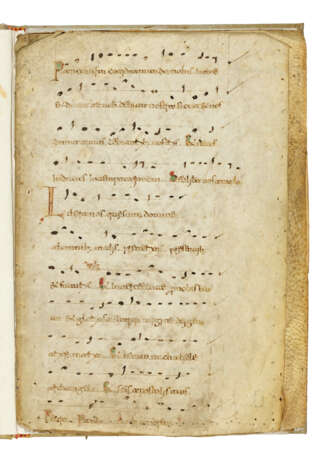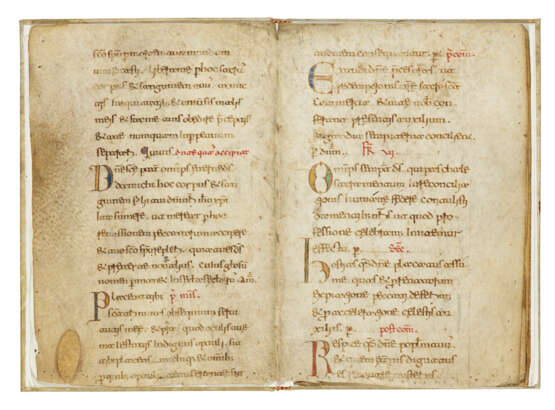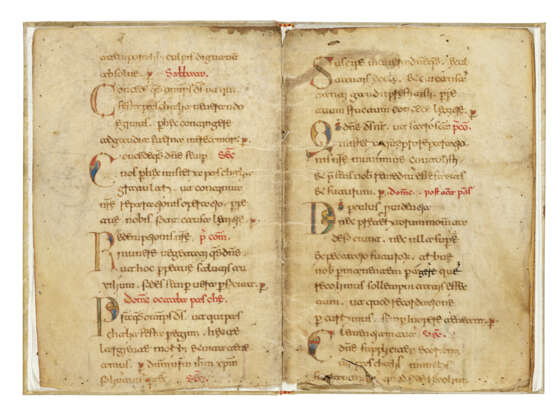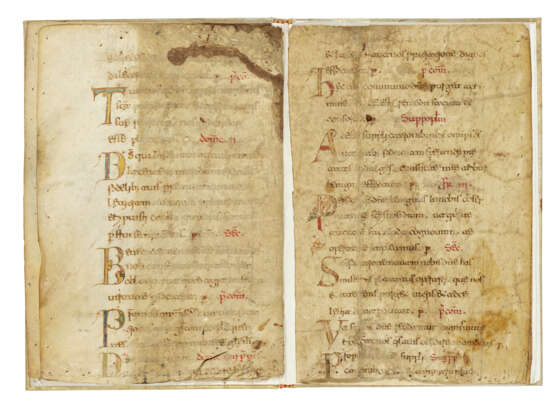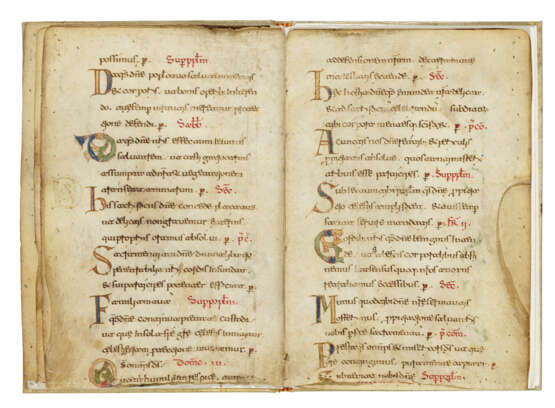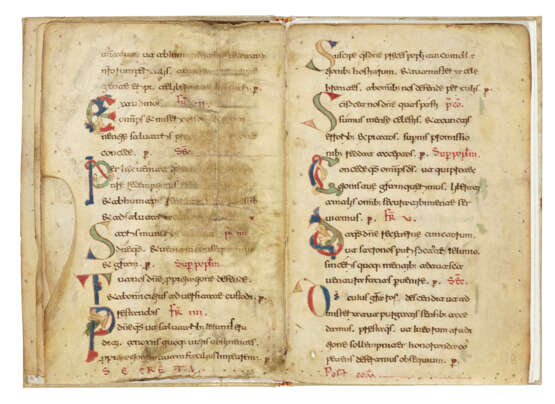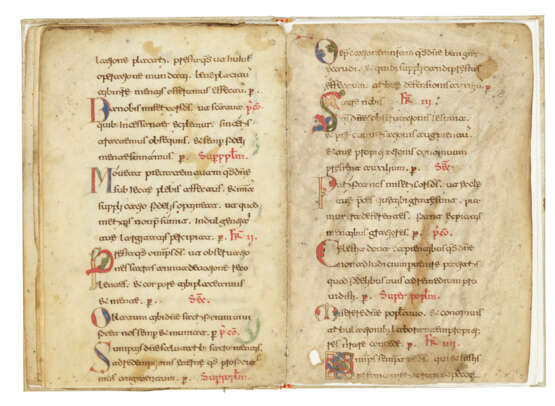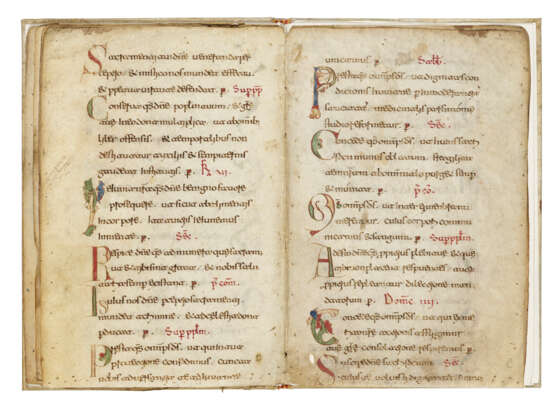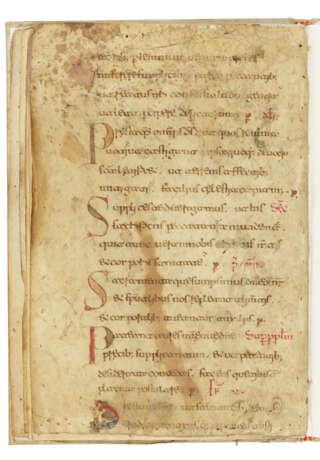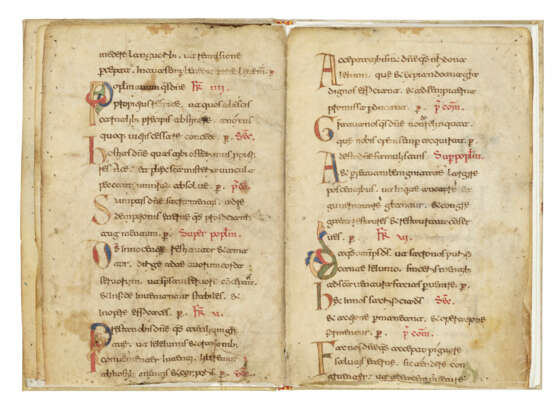ID 1053138
Lot 24 | Beneventan neumes
Valeur estimée
£ 70 000 – 100 000
Sacramentary, in Latin, decorated manuscript on vellum [Italy, probably Bari, early 12th century]
An exceptional survival of a Beneventan Mass Book: the only Beneventan Bari-type Sacramentary known.
12 leaves, c.230 x 150mm, blind-ruled for 21 lines written in brown ink in a Beneventan minuscule of the Bari type, ruled space: c.210 x 90mm, Beneventan neumes on a ruled 1-line F-staff, small initials with yellow, red or blue wash, one hundred and six 3-line capitals, including 20 intertwined initials mostly with foliate decoration and zoomorphic finials filled with yellow, blue, red and green wash (some staining and darkening, some fading to a few lines, some cuts, creasing and holes). Bound in modern vellum, sewn on 4 cords.
Provenance:
(1) Christie’s 26 June 1996, lot 12.
(2) Schøyen Collection, MS 2204.
Text:
A Sacramentary differs from a Missal in that it contains only the texts said by the priest officiating at Mass: for proper Masses these are the collect, secret, preface, and postcommunion (a Missal additionally includes the Epistle and Gospel readings, which are read by a sub-deacon and deacon, and may indicate the parts sung by the choir, found in full in a Gradual). The text here is from the portion of the Sacramentary for Ferial Masses, containing the Celebrant’s prayers for each day in succession.
An interesting counter to the dominant theory that the Missal had, by the 12th century, for a variety of practical and ecclesiological reasons, rendered the Sacramentary redundant can be found in an 11th-century list of sumptuous 'ecclesiastica ornamenta' purchased or ordered by the bibliophile abbot of Montecassino Desiderius and compiled by the abbey librarian, Leo Marsicanus (Chronica monasterii casinensis 3,18). In it, Marsicanus describes the commission of two silver-bound Sacramentaries, two Gospel books and one Epistolary to combat the 'inhonestum' practice of reading the mass lections from a single Missal (on this see A.J.M. Irving, 'On the counting of Mass Books', Archiv für Liturgiewissenschaft, 57 (2015), pp.24-48). Desiderius' feelings on the matter notwithstanding, Beneventan Sacramentaries from this period are far scarcer than Missals: only one complete Beneventan Sacramentary survives, Montecassino 339. The present fragment is the only surviving example of a Sacramentary written in Bari-type Beneventan script.
Script and music:
This leaf is written in the rare ‘Bari-type’ sub-style of Beneventan minuscule, practised mainly in Puglia and Dalmatia. It is characterised especially by the fact that the minims are written more like Caroline minuscule than the Montecassino type of the script, in which minims have a thick-thin-thick appearance, like stacked lozenge shapes. Apart from this, most letter-forms are similar, except for the shape of the letter ‘c’, which looks like a large reversed ‘3’. E.A. Lowe, The Beneventan Script, 1914, p.150 (revised edition by V. Brown, 1980), provides the most detailed discussion of Bari-type Beneventan script, although there is also an unpublished 1961 dissertation, summarised in E.B. Levy, ‘The Bari Type of Beneventan Script: Manuscripts from Apulia’, Harvard Studies in Classical Philology 66 (1962), pp.262–65.
Sacramentaries generally have very little musical notation. This manuscript fortunately includes the two final pages of the Canon of the Mass, including the notated chants of the Lord’s Prayer and concluding with the Giving of the Peace. The melodies are rather simple, and notated around a single ruled stave-line, without clef.
| Lieu d'origine: | Italie |
|---|---|
| Catégorie maison de vente aux enchères: | Manuscrits médiévaux et de la Renaissance |
| Lieu d'origine: | Italie |
|---|---|
| Catégorie maison de vente aux enchères: | Manuscrits médiévaux et de la Renaissance |
| Adresse de l'enchère |
CHRISTIE'S 8 King Street, St. James's SW1Y 6QT London Royaume-Uni | ||||||
|---|---|---|---|---|---|---|---|
| Aperçu |
| ||||||
| Téléphone | +44 (0)20 7839 9060 | ||||||
| Commission | see on Website | ||||||
| Conditions d'utilisation | Conditions d'utilisation |
